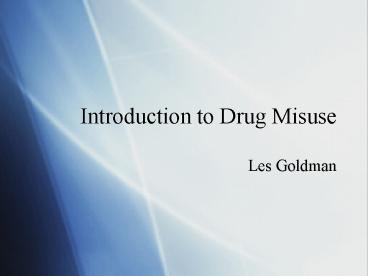Introduction to Drug Misuse PowerPoint PPT Presentation
1 / 16
Title: Introduction to Drug Misuse
1
Introduction to Drug Misuse
- Les Goldman
2
Objectives
- Gain basic knowledge of
- Common current patterns of drug misuse
- Local referral pathways
- Available treatments
3
Commonly misused drugs
- Cannabis - draw weed
- Ecstasy, LSD
- Solvents
- Amphetamines - whizz
- Opiates - gear brown
- Cocaine - crack rock stone
- Benzodiazepines - blues
4
Common patterns of drug misuse
- Primary heroin IV or inhaled plus
- Methadone, DHC etc when supplies low
- Benzodiazepines for depression
- Cocaine occasionally as treat
- Cannabis daily
- Primary cocaine use - intense binges plus
- Heroin and/or benzos afterwards
- Cannabis
5
Harmful effects result from
- Properties of drug
- Hallucinogen - ecstasy, LSD
- Depressant - opiates, benzodiazepines
- Stimulant - amphetamine, cocaine
- Addictive potential
- Mode of administration
- Oral - overdose risk
- Smoked / inhaled - heat, tobacco, ash, toxic
fumes - Injected - overdose and infection risk, arterial
injury, DVT - Use in combination
- With other drugs
- With alcohol
6
Primary Care interventions - assessment 1
- 5 areas
- Drug use (which drugs, quantity used, duration of
use, mode of administration, experience of
withdrawal and overdose, previous treatment) - Physical health
- Psychological health
- Social circumstances (friends, family support,
housing, work) - Involvement with criminal justice system
7
Primary Care interventions -assessment 2
- Objective confirmation
- History
- Examination
- Investigation
8
Primary Care interventions - motivation
- Cycle of change - something to offer at each
stage - Precontemplation
- Contemplation
- Action
- Maintenance
- Relapse
9
Primary Care interventions - harm reduction
- Accurate information about drug effects and risks
- Verbal
- Written
- Encourage safer pattern of use
- Care with combinations of drugs / alcohol
- Smoke rather than inject
- Safer smoking / injecting techniques
- Manage physical health problems
- Preventive health care
- Overdose prevention (dont inject alone, learn
basic CPR) - Vaccination (hep A, hep B, tetanus)
10
Appropriate referral 1
- Bridge Project (non-statutory)
- Counselling, harm reduction, needle exchange
- Activities (music, IT, gym, complementary
therapies) - Treatment
- Womens Service
- Young Peoples Service
- Stimulant Service
11
Appropriate referral 2
- PCT level primary care based services
- NBPCT Drug Service
- Ripple Project
- City SMS
- Personnel - GPwSI, CPN, physical health nurse,
drugs worker, vocational advice, social support,
carer support, community development - Principally opiate dependence services
- Main exclusions
- Complex poly - substance misuse
- Serious mental health problems
- Young people
12
Appropriate referral 3
- Specialist Services
- CDAT (Horton Park Centre)
- One Stop Maternity Service
- Young Peoples Service
- Day Care
- Detoxification programmes
- Other services
- Carers
- Self help (Narcotics Anonymous)
13
Criminal Justice and Drugs
- Drug Intervention Programme (DIP)
- Restriction on Bail (ROB)
- Drug Treatment Testing Order (DTTO)
- Support workers
- Structured activities
14
Principles of treatment 1 choice of intervention
- Substitute prescribing
- Appropriate for e.g. opiate and benzodiazepine
misuse - Harm reduction
- Physical
- Psychological
- Social
- Maintenance / detoxification
- Symptomatic relief
- Appropriate for e.g. cocaine misuse
- Relapse prevention
- Medical - naltrexone
- Non medical - supportive counselling
15
Principles of treatment 2 choice of
opiate substitute
- Methadone
- Long acting
- Cant inject mixture
- Sedating
- Withdrawal sometimes difficult
- Buprenorphine (Subutex)
- Long acting
- Blocking effect (safer but risk of precipitate
withdrawal on starting treatment) - Less sedating
- Easier withdrawal
- Dihydrocodeine
- Easily diverted
- Easier withdrawal, useful for quick detox
- Less potent
16
More information
- Drug Misuse and Dependence - Guidelines on
Clinical Management DoH 1999 - www.smmgp.co.uk
- Guidelines and info
- www.drugscope.org.uk
- Easy to use source of information
- www.nta.nhs.uk
- DoH agency commissioning drug misuse services

